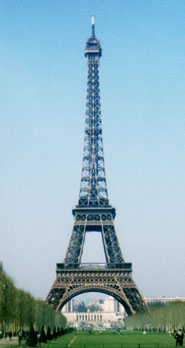Eiffel Tower
The Eiffel Tower is the most recognizable landmark in Paris and is known worldwide as a symbol of France. Named after its designer, Gustave Eiffel, it is a premier tourist destination, with over 5.5 million visitors per year.
(The name Eiffel is pronounced in French EfEl in X-SAMPA, but English speakers often adopt a German-sounding pronunciation ajfEl.)
Background
The structure was built from 1887 to 1889 as the entrance arch for the Exposition Universelle (1889), a World's fair marking the centennial celebration of the French revolution. It was inaugurated on March 31, 1889, and opened on May 6. 300 workers joined together 18,038 pieces of puddled iron, using two and a half million rivets. Considering the safety standards in place at the time, it is remarkable that only one worker died in the construction of the tower (during the installation of Otis Elevator's lifts).
The tower is 300 meters (986 feet) tall, not including the 20-meter television antenna on top, and weighs over 10,000 tons (over 21,000,000 pounds). It was the world's tallest structure for forty years. The summit is reached by 1,792 steps of stairs - the same as the year of the First French Republic.
Maintenance on the tower include 50 tons of three graded tones of paint every 7 years. On occasion, the color of the paint is changed. The tower is currently painted to a shade of brown. On the first floor, there are interactive consoles hosting a poll for the color to use for a future session of painting. Depending on the ambient temperature, the top of the Eiffel Tower will shift away from the sun by eight centimetres because of expansion of the sun-warmed metal.
The tower was met with resistance from the public when it was first built, since many thought it would be an eyesore. Today, it is widely considered to be one of the most striking pieces of architectural art in the world.
One of the great Hollywood movie clichés is that the view from a Parisian window always includes the Eiffel Tower.
Originally, Eiffel had a permit to leave the tower standing for 20 years, more than recouping his expenses, but as it proved valuable for communication purposes, it was allowed to stay after the end of the permit.
Events
On January 12, 1908, the first long-distance radio message was sent from the tower.
File:Eiffel.trocadero.250pix.jpg
View from the Tower to the northwest across the River Seine, showing the Trocadéro gardens and the Palais de Chaillot. A pleasure boat cruises on the river.
Father Theodor Wulf in 1910 took observations of radiant energy radiation at the top and bottom of the Eiffel Tower, discovering more than was expected at the top, and thereby detecting what are today known as cosmic rays.
In 1925, the con artist Victor Lustig twice "sold" the Eiffel Tower for scrap.
In 1929, the Tower lost the title of the World's tallest structure when the Chrysler Building was completed in New York.
When Adolf Hitler visited occupied Paris in 1940, the lift cables were cut by the French so that he would have to climb the 1792 steps to the summit - the part to repair them was allegedly impossible to obtain because of the war, though it was working again within hours of the departure of the Nazis. He chose to stay on the ground.
On January 3, 1956 a fire damaged the top of the tower.
In 1959 the present radio antenna was added to the top.
In the 1980s an old restaurant and its supporting iron scaffolding midway up the tower was dismantled; this was purchased and reconstructed in New Orleans, Louisiana, originally as the Tour Eiffel Restaurant, more recently known as the Red Room.
In the year 2000, flashing lights and several high-power searchlights were installed on the tower. Since then the light show has become a nightly event. The searchlights on top of the tower make it a beacon in Paris' night sky.
The tower received its 200,000,000th guest on November 28, 2002.
At 19:20 on July 22, 2003, a fire occurred at the top of the tower in the broadcasting equipment room. The entire tower was evacuated; the fire was extinguished after forty minutes, and there were no reports of injuries.
File:Eiffel.cdmars.250pix.smaller.jpg
View from the Tower down the Champ de Mars to the southeast, with the Tour Montparnasse (Montparnasse Tower) in the distance.
Reproductions and imitations
Several reproductions / models of the Eiffel Tower (often smaller-scale) exist. In order of decreasing size:
- Tokyo, Japan called the Tokyo Tower (13 meters higher than the original, scale 1.04:1)
- Blackpool, England - Blackpool Tower 158 meters (519 feet) tall is not quite a free-standing structure; it stands above the Tower Circus complex, where the four "legs" can be seen.
- in front of Paris Hotel, Paradise, Nevada, near Las Vegas, USA 165 meters (540 feet) high (scale 1:2)
- Shenzhen, China (scale 1:3)
- King's Island theme park, Ohio (scale 1:3)
- Paramount Park's Kings Dominion, Virginia. A 84 m (275-ft) reproduction is available for the amusement of visitors. (scale 1:3.59)
- Guatemala City, Guatemala - Torre del Reformador, 75 meters tall (scale 1:4)
- Prague, Czech Republic (scale 1:5), Petrinska rozhledna, built in 1891
- Slobozia, Romania, 54 meters tall
- Wembley Park, London - Watkins' Tower
- Woodwards Building, Vancouver, Canada. A small reproduction on the roof of the building is topped by a signature neon "W". This building is now being converted into social housing.
See also
Access
- Metro: Trocadéro (9) or Bir-Hakeim (6)
- RER: Champs-de-Mars - Tour-Eiffel (C)

